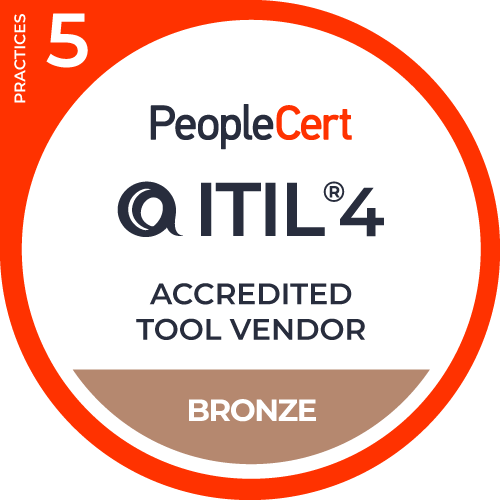Ever wondered why the same IT issues keep cropping up, disrupting your business operations? How do companies identify and fix these recurring problems for good?
In this article, we'll explore the crucial role of a problem manager, the responsibilities they hold, and the best practices they employ to ensure IT services run smoothly.
What skills are essential for a problem manager? How do they overcome common challenges? And what tools do they rely on? Keep reading to uncover the answers to these questions.
What is Problem Management?
Problem Management is a systematic approach to managing the lifecycle of all problems encountered during IT service delivery. Unlike Incident management, which focuses on restoring services as quickly as possible, Problem Management aims to identify and resolve the root causes of recurring issues and find permanent solutions.
It is a critical aspect of IT Service Management (ITSM), alongside other essential processes such as Incident Management, Change Management, and Service Request Management. The ITIL (Information Technology Infrastructure Library) framework is widely adopted for guiding ITSM practices, including Problem Management.

Incident Management vs Problem Management: Definition & Differences
Roles and responsibilities of a Problem Manager
The Problem Manager's role is to ensure the reliability and continuity of IT services. Their primary responsibility is to address the root causes of recurring incidents, preventing them from recurring and affecting business operations.
Key responsibilities:
-
Root cause analysis: Conduct thorough investigations to identify the underlying causes of recurring incidents. This involves analyzing incident data, reviewing system logs, and collaborating with technical teams to pinpoint the source of problems.
-
Coordination and collaboration: Work closely with various teams, including IT support, development, and operations, to gather information, tools, and expertise needed to resolve problems. Effective coordination ensures that all relevant stakeholders are involved in the problem-solving process.
-
Implementation of solutions: Develop and implement permanent solutions to address identified root causes. This may involve deploying software patches, updating configurations, or redesigning processes to prevent future incidents.
-
Continuous improvement: Monitor the effectiveness of implemented solutions and make necessary adjustments. Continuously seek ways to improve Problem Management processes and reduce the occurrence of incidents.

Root Cause Analysis (RCA), Explained
Skills and qualifications of a Problem Manager
A Problem Manager needs a combination of problem-solving abilities, technical and analytical skills, and good communication:
-
Technical proficiency: A deep understanding of the organization's IT infrastructure is crucial. Problem managers must be familiar with the various components, systems, and technologies used within the organization to diagnose and resolve issues effectively.
-
Problem-solving abilities: Creativity, critical thinking, and persistence are vital for identifying and resolving complex problems. Problem managers should be able to think outside the box and explore innovative solutions to recurring issues.
-
Analytical skills: The ability to analyze real-time metrics and data is essential for spotting trends, drawing insights, and identifying root causes. Problem managers should be comfortable working with data and using analytical tools to support their investigations.
-
Effective communication: Strong communication skills are necessary for relaying information to technical teams, vendors, users, and other stakeholders. Problem managers must be able to explain complex technical issues in a clear manner, ensuring that everyone involved understands the situation and the proposed solutions.
Unlocking Career Progression
Discover the strategies to lifelong learning and evolvement in IT
Download for free
Proactive Problem Management strategies
Proactive Problem Management involves analyzing data to identify trends or significant problems before they escalate. This preventive approach minimizes the impact of incidents and improves overall service reliability. Problem managers work closely with incident management, Change Management, and other service teams to develop and implement solutions.
Tools and software for Problem Management
Problem managers need a diverse toolkit tailored to address the multifaceted challenges of IT Problem Management. Essential tools include:
-
Problem Management module: Integrates with other key modules such as incident management and change management to provide a cohesive approach to problem resolution.
-
Configuration Management Database (CMDB): Helps understand dependencies and interrelationships between different components within the IT infrastructure.
-
Known Error Database (KEDB): Facilitates quick resolution by providing information on known errors and their workarounds.

8 Steps to Build a Solid Problem Management Process
Measuring Problem Management effectiveness
Key performance metrics for evaluating Problem Management effectiveness include:
-
Percentage of problems with identified root cause: Measures the success of diagnosing issues.
-
Percentage of problems with permanent solution or workaround: Indicates the effectiveness of implementing resolutions.
-
Proficiency in evaluating risks: Assesses the ability to prioritize fixes based on business impact and urgency.
Problem managers should also calculate the return on investment (ROI) for their work to demonstrate value and prioritize problem fixes according to business needs.
Career development and training for Problem Managers
Problem Management offers a lucrative and rewarding career path. A bachelor's degree in business, computer science, or a related technical field is typically required, along with 2 to 4 years of experience in Problem Management or related roles. Essential skills include business acumen, leadership, and analytical abilities.
Overcoming common challenges in Problem Management
Problem Management is essential for maintaining the stability of IT services, but it comes with its own set of challenges. Let's dive into some common obstacles and how problem managers can effectively address them.
Lack of data and metrics
Without adequate data, identifying problems and their root causes becomes challenging. Consider a scenario where a company's website experiences intermittent outages. Without detailed logs and performance metrics, pinpointing the exact cause—whether it's a server issue, a network problem, or a software bug—can be nearly impossible.
How to address it: Problem Managers should implement comprehensive monitoring and logging tools. They can analyze trends and detect anomalies by collecting detailed data on system performance, user activity, and error occurrences.
Misalignment with business goals
When Problem Management efforts are not aligned with business objectives, prioritization can suffer. Imagine a situation where a problem manager is focused on resolving a low-impact bug in an internal tool while a critical customer-facing application faces repeated outages. This misalignment can lead to wasted resources and increased customer dissatisfaction.
How to Address It: Problem Managers should regularly communicate with business leaders to understand their priorities and objectives. Regular meetings and reporting can help align the Problem Management team with the broader business strategy.
Lack of leadership support
Without strong support from leadership, Problem Managers may struggle to secure the resources and authority needed to address issues effectively. For instance, if a problem manager identifies that outdated hardware is causing frequent server crashes but doesn't get approval for an upgrade, the problem will persist.
How to address it: The problem manager must know how to build a compelling case for the importance of their work and highlight the potential business impact of unresolved problems. This includes demonstrating the cost of downtime, the risk to customer satisfaction, and potential compliance issues.
Insufficient skills and resources
Building a strong Problem Management process will require a blend of technical expertise, analytical skills, and sufficient manpower. A team lacking in these areas may find it challenging to diagnose and resolve problems efficiently.
How to address it: Investing in continuous training and development for the Problem Management team is crucial. Providing opportunities for skill enhancement through courses, certifications, and hands-on experience ensures the team remains capable and up-to-date with the latest technologies. Additionally, ensuring adequate staffing levels and access to necessary tools and resources can significantly enhance problem-solving capabilities.
Conclusion
The role of a problem manager is crucial for maintaining reliable IT services. By identifying and resolving root causes of recurring issues, problem managers help prevent future incidents, ensuring smoother operations across the organization.
Key takeaways:
-
Core responsibilities: Conduct root cause analyses, coordinate with various teams, and implement lasting solutions.
-
Skills needed: Technical expertise, problem-solving abilities, analytical skills, and effective communication.
-
Challenges: Lack of data, misalignment with business goals, insufficient support, and limited resources. These can be addressed by improving data collection, clear communication with leadership, and continuous team training.
Problem Management isn't just about fixing issues—it's about creating a proactive culture that anticipates and prevents problems. One way of doing this is by following ITIL's best practices; it can help you align your Problem Management processes with industry standards and organizational goals.
You can dive deeper into ITIL and explore related practices like Incident Management and Change Management to see how they work together to create a more reliable and efficient IT environment.
For those eager to enhance their ITSM knowledge, the ITIL practices offer a great starting point to help you master Problem Management and other essential practices.




